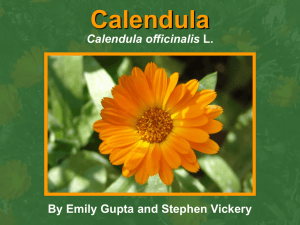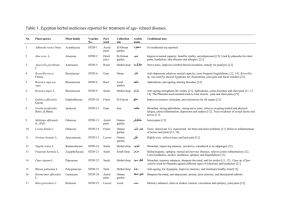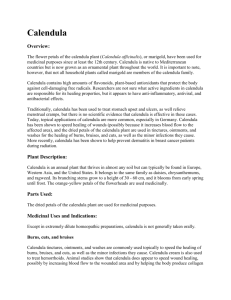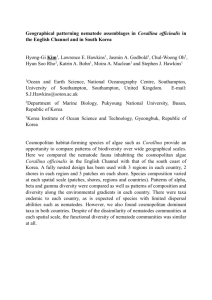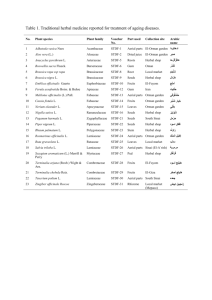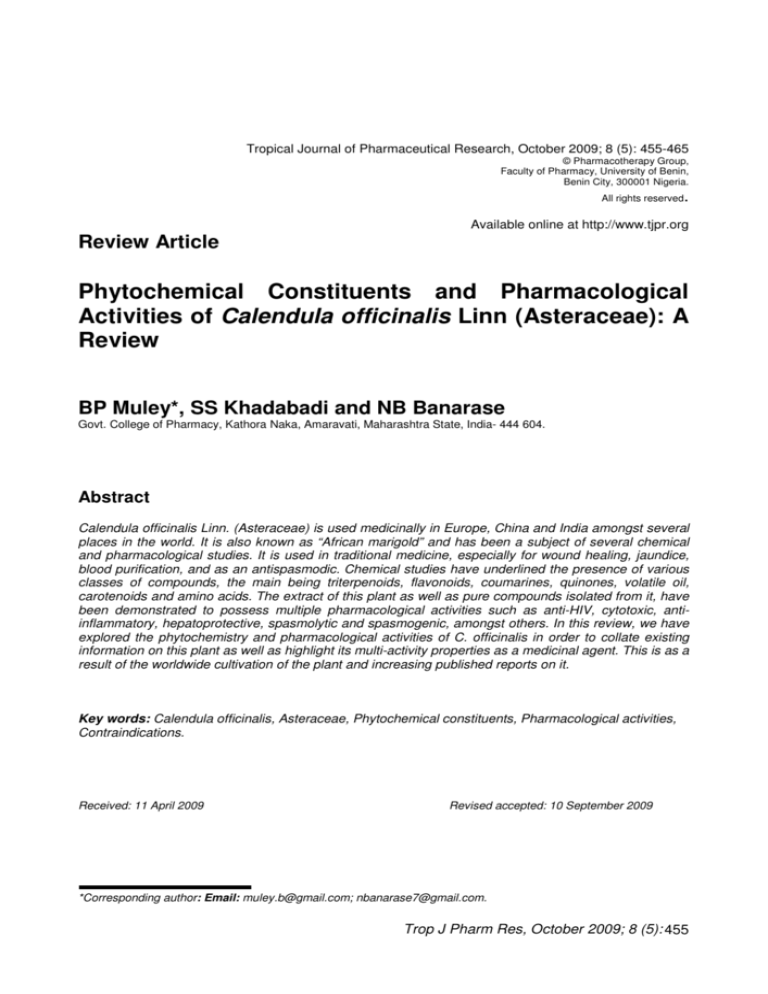
Muley et al
Tropical Journal of Pharmaceutical Research, October 2009; 8 (5): 455-465
© Pharmacotherapy Group,
Faculty of Pharmacy, University of Benin,
Benin City, 300001 Nigeria.
.
All rights reserved
Available online at http://www.tjpr.org
Review Article
Phytochemical Constituents and Pharmacological
Activities of Calendula officinalis Linn (Asteraceae): A
Review
BP Muley*, SS Khadabadi and NB Banarase
Govt. College of Pharmacy, Kathora Naka, Amaravati, Maharashtra State, India- 444 604.
Abstract
Calendula officinalis Linn. (Asteraceae) is used medicinally in Europe, China and India amongst several
places in the world. It is also known as “African marigold” and has been a subject of several chemical
and pharmacological studies. It is used in traditional medicine, especially for wound healing, jaundice,
blood purification, and as an antispasmodic. Chemical studies have underlined the presence of various
classes of compounds, the main being triterpenoids, flavonoids, coumarines, quinones, volatile oil,
carotenoids and amino acids. The extract of this plant as well as pure compounds isolated from it, have
been demonstrated to possess multiple pharmacological activities such as anti-HIV, cytotoxic, antiinflammatory, hepatoprotective, spasmolytic and spasmogenic, amongst others. In this review, we have
explored the phytochemistry and pharmacological activities of C. officinalis in order to collate existing
information on this plant as well as highlight its multi-activity properties as a medicinal agent. This is as a
result of the worldwide cultivation of the plant and increasing published reports on it.
Key words: Calendula officinalis, Asteraceae, Phytochemical constituents, Pharmacological activities,
Contraindications.
Received: 11 April 2009
Revised accepted: 10 September 2009
*Corresponding author: Email: muley.b@gmail.com; nbanarase7@gmail.com.
Trop J Pharm Res, October 2009; 8 (5): 455
Muley et al
INTRODUCTION
India is called the botanical garden of the
world for its rich natural resources. Over
6,000 plants in India are used in traditional,
folklore and herbal medicine[1]. The Indian
system of medicine has identified 1500
medicinal plants of which 500 are commonly
used[1]. Calendula officinalis Linn. is used
medicinally in Europe, China, US and India. It
belongs to the family, Asteraceae, and is
commonly known as Zergul (Hindi), African
marigold, Calendula, Common Marigold,
Garden Marigold, Marigold, Pot Marigold
(English), Butterblume (German), Chin Chan
Ts’ao (Chinese), Galbinele (Romanian) and
Ringblomma (Swedish)[2,3].
Taxonomic description
up of orange-yellow tubular florets. The disc
florets are pseudohermaphrodites but the
female is sterile. The zygomorphic ray florets
at the edge are female, their stamens are
completely absent, and their inferior ovaries
are much more developed than those of the
tubular florets. The fruit forms only in the
female ray flowers. The heterocarp achenes
are sickle-shaped, curved and ringed.
Leaf, stem and root
The plant is an annual, seldom biennial. It
grows to between 30 and 50 cm high, and
has about 20 cm long tap root and numerous
thin, secondary roots. The stem is erect,
angular, downy and branched from the base
up or higher. The alternate leaves are almost
spatulate at the base, oblong to lanceolate
above and are all tomentosae[5-7].
The plant is classified as shown in Table 1.
Table 1: Taxonomic classification of Calendula
officinalis [4]
Kingdom
Plantae
Subkingdom
Division
Class
Subclass
Order
Family
Tribe
Genus
Species
Tracheobionta
Magnoliophyta
Magnoliopsida
Asteridae
Asterales
Asteraceae
Calenduleae
Calendula
C. officinalis
Habitat
The plant is native to Central and Southern
Europe, Western Asia and the US [5].
Botanical description
Flower and fruit
On the tip of each stem, there is a 5 to 7 cm
composite flower head, as shown in Fig 1,
consisting of an epicalyx of numerous
narrow-lanceolate sepals, which are densely
covered on both sides with glandular hairs.
The inner section of the flower head is made
Leaves with stem
Flower
Fig 1: The leaf, stem and flower of C. officinalis
Traditional uses
In Europe, the leaves are considered
resolvent and diaphoretic while the flowers
are used as a stimulant, antispasmodic and
emmenagogue[2]. In England, the decoction
of the flowers was used as a posset drink for
the treatment of measles and smallpox, and
the fresh juice as a remedy for jaundice,
costiveness (constipation) and suppression of
menstrual flow [8]. In India, the florets are
used in ointments for treating wounds,
herpes, ulcers, frostbite, skin damage, scars
and blood purification. The leaves, in
infusion, are used for treating varicose veins
externally [2,8].
Trop J Pharm Res, October 2009; 8 (5): 456
Muley et al
PHYTOCHEMISTRY
A number of phytochemical studies have
demonstrated the presence of several
classes of chemical compounds, the main
ones
being
terpenoids,
flavonoids,
coumarines,
quinones,
volatile
oil,
carotenoids and amino acids.
Terpenoids
Various terpenoids (Table 2) have been
reported from the petroleum ether extract of
C.officinalis flowers. They include sitosterols,
stigmasterols[9], diesters of diols[10], 3monoesters of taraxasterol, ψ-taraxasterol,
lupeol[11,12],
erythrodiol,
brein[13,14],
ursadiol[15], faradiol-3-O-palmitate, faradiol3-O-myristate,
faradiol-3-O-laurate[16],
arnidiol-3-O-palmitate, arnidiol-3-O-myristate,
arnidiol-3-O-laurate,
calenduladiol-3-Opalmitate, calenduladiol-3-O-myristate[17,18],
oleanolic acid saponins: calenduloside AH[19-22],
oleanane triterpene glycoside:
calendulaglycoside A, calendulaglycoside
A6′-O-n-methyl ester, calendulaglycoside A6’O-n-butyl ester, calendulaglycoside B,
calendulaglycoside B 6′-O-n-butyl ester,
calendulaglycoside C, calendulaglycoside C
6′-O-n-methyl ester, calendulaglycoside C 6′O-n-butyl ester, calenduloside F6′-O-n-butyl
ester, calnduloside G6′-O-n-methyl ester[18],
glucosides of oleanolic acid (mainly found in
roots of grown and senescing plants) I, II, III,
VI, VII [23,24], and glucuronides (mainly
found in flowers and green parts) F, D, D2, C,
B and A[25]. One new triterpenic ester of
olanane series has been isolated from
flowers was cornulacic acid acetate from
flowers [26].
Flavonoids
Various flavonoids (Table 3) have been
isolated from the ethanol extract of the
inflorescence of C. officinalis. They include
quercetin, isorhamnetin[27], isoquercetin,
isorhamnetin-3-O-β-D-glycoside,
narcissin,
calendoflaside
[28],
calendoflavoside,
calendoflavobioside,
rutin,
isoquercitrin,
neohesperidoside,
isorhamnetin-3-OG
neohesperidoside,
isorhamnetin-3-O-2 rhamnosyl rutinoside,
isorhamnetin-3-Orutinoside,
quercetin-3-O-glucoside
and
quercetin-3-O-rutinoside[18].
Coumarins
The ethanol extract of the inflorescence of
the C. officinalis reported to contain
coumarins - scopoletin, umbelliferone and
esculetin [29] .
Quinones
Quinones reported from C. officinalis were
plastoquinone, phylloquinone, α-tocopherol in
the chloroplast, ubiquinone, phylloquinone, αtocopherol
in
mitochondria,
and
phylloquinone in the leaves [30].
Volatile oil
C. officinalis flowers contain maximum
volatile oil at full flowering stage (0.97 %) and
minimum during the preflowering stage (0.13
%) [31]. The composition also showed
different patterns at different phases of
vegetative cycles. Various monoterpenes and
sesquiterpenes have been reported in the
volatile oil : α-thujene, α-pienene, sabinene,
β-pienene, limonene, 1,8-cineol, p-cymene,
trans-β-ocimene, γ-terpenene, δ-3-carene,
nonanal, terpene-4-ol, 3-cylohexene-1-ol, αphellandrene,
α-terpeneol,
geraniol,
carvacrol, bornyl acetate, sabinyl acetate, αcubebene, α-copaene, α-bourbonene, βcubebene, α-gurjunene, aromadendrene, βcaryophyllene, α-ylangene, α-humulene, epibicyclo-sequiphellandrene, germacrene D,
alloaromadendrene, β-saliene, calarene,
muurolene, δ-cadinene, cadina 1,4-diene, αcadinene,
nerolidol,
palustron,
endobourbonene, oplopenone, α-cadinol, Tmuurolol. The essential oil was found to be
rich in α-cadinene, α-cadinol, t-muurolol,
limonene, and 1,8-cineol with p-cymene at
lower levels at the post-flowering periods
[31].
Trop J Pharm Res, October 2009; 8 (5): 457
Muley et al
Table 2: Structures and activities of some terpenoids
Structure
Activity
1
Triterpenoid
2
3
Calendulaglycoside A: R =Glc, R =Gal, R =H,
4
R =Glc;
1
Calendulaglycoside A6’-O-methyl ester: R =Glc,
2
3
4
R =Gal, R =Me, R =Glc;
1
Calendulaglycoside A6’-O-n-butyl ester: R =Glc,
2
3
4
R = Gal, R =n-Bu, R =Glc;
1
2
3
Calendulaglycoside B: R =Glc, R =Gal, R = H,
4
R = H;
1
Calendulaglycoside B6’-O-n-butyl ester: R =Glc,
2
3
4
R =Gal, R =n-Bu, R =H;
1
2
3
Calendulaglycoside C: R =H, R =Gal, R =H,
4
R =Glc;
1
Calendulaglycoside C6’-O-methyl ester: R = H,
2
3
4
R =Gal, R =Me, R =Glc;
1
Calendulaglycoside C6’-O-n-butyl ester: R =H,
2
3
4
R =Gal, R =n-Bu, R =Glc;
1
Calendulaglycoside F6’-O-n-butyl ester: R =H,
2
3
4
R =Gal, R =Me, R =H
1
2
3
Faradiol: R =OH, R =R =H
1
2
3
ψ-Taraxasterol: R =R =R =H
Responsible for
antitumor, antiinflammatory and
antioedematous
activities.
Responsible for
anti-inflammatory
and
antioedematous
activities.
Triterpenoid saponin
Carotenoids
The methanol extract of leaves, petals and
pollens of C. officinalis flowers showed a
number of carotenoids. The carotenoids
found in the pollens and petals were
neoxanthin, 9Z-neoxanthin, violaxanthin,
luteoxanthin, auroxanthin, 9Z-violaxanthin,
flavoxanthin,
mutatoxanthin,
9Zanthroxanthin, lutein, 9/9′A-lutein, 13/13′Zlutein, α-cryptoxanthin, β-cryptoxanthin, zcryptoxanthin, lycopene, α-carotene, and βcarotene. Total carotenoids (mg/g dry weight)
was 7.71 % for petals and1.61 % for pollens.
Reported carotenoid compositions of the
leaves and stems reported were neoxanthin,
9Z-neoxanthin, violaxanthin, luteoxanthin, 9Z-
violaxanthin,
13Z-violaxanthin,
antheraxanthin,
mutatoxanthin
epimer
1,
mutatoxanthin epimer 2, lutein, 9/9′ 2-lutein,
α-cryptoxanthin, β-cryptoxanthin, β-carotene.
Total carotenoids (mg/g dry weight) for the
leaves is 0.85 % and for stems 0.18 %
[32,33].
Amino acids
The ethanol extract of the flowers of the plant
is reported to show the presence of 15 amino
acids in free form: alanine, arginine, aspartic
acid, aspargine, valine, histidine, glutamic
acid, leucine, lysine, proline, serine, tyrosine,
threonine, methionine and phenylalanine.
Amino acid content of the leaves is about 5
%, stems 3.5 % and flowers 4.5 % [34].
Trop J Pharm Res, October 2009; 8 (5): 458
Muley et al
Table 3: Structures and activities of some flavonoids
Structure
Activity
1
Isorhamnetin3-O-neohesperidoside
2
3
R =Me,
R =Rha,
R =H;
G
Isorhamnetin3-O-2 1
rhamnosylrutinoside: R =Me,
2
3
R =Rha, R =Rha;
Isorhamnetin3-O-rutinoside:
1
2
3
R =Me, R =H, R =Rha;
1
Quercetin-3-O-glucoside: R =
2
3
H, R =H, R =H; Quercetin-31
2
O-rutinoside: R =H, R =H,
3
R =Rha
Responsible for
antioxidant and
wound healing
activities
Responsible for
antioxidant
activities
Quercetin
Responsible for
antioxidant
activities
Isorhamnetin
Carbohydrates
The ethanol extract of the inflorescence of
plant
showed
the
presence
of
polysaccharides, PS-I,-II, and -III having a
(1→3)-β-D-galactam backbone with short
side chains at C-6 comprising α-araban(1→3)-araban and alpha-L-rhamnan-(1→3)araban along with monosaccharides [35,36].
Lipids
The lipids in the petroleum ether extract of
the seeds, leaves and flowers of C. officinalis
have been analyzed. The amount of neutral
lipids in the seeds was 15.7 %, phospholipids
0.6 % and glycolipids 0.9 %. Fatty acids of
monols, sterol esters, 3-monoesters, 3monoester diols reported in flowers were
lauric, myristic, palmitic, stearic, oleic, linoleic
and linolenic acid. The fatty acids of marigold
seeds contain about 59% of an 18:3
conjugated trienic (trans-8,trans-10, cis-12)
acid and about 5% of 9-hydroxy-18:2 (trans9,cis-11) acid - dimorphecolic acid [37,38]
one oxygenated fatty acid also reported from
the seed oil of C. officinalis was D-(+)-9hydroxy-10,12-octadecadienoic acid [39].
Other constituents
Other phtytochemicals include the bitter
constituent, loliolide (calendin) [40], calendulin
[41] and n-paraffins [42].
Trop J Pharm Res, October 2009; 8 (5): 459
Muley et al
PHARMACOLOGICAL ACTIVITIES
Pharmacological studies have confirmed that
C.officinalis exhibit a broad range of
biological effects, some of which are very
interesting for possible future development.
Anti-inflammatory
activities
and
antioedematous
Ethyl acetate soluble fraction of the methanol
extract of C. officinalis flowers exhibited the
most potent inhibition (84 %) of 12-otetradecanoyl phorbol-13-acetate (TPA)induced inflammation (1 µg/ear) in mice with
an ID50 value of 0.05 - 0.20 mg/ear compared
with indomethacin as reference drug.
Furthermore, activity-guided isolation showed
that its activity was mainly due to oleananetype triterpene glycoside[18]. A dose of 1200
µg/ear of an aqueous-ethanol extract showed
20 % inhibition in croton oil-induced mouse
oedema. The activity was attributed to the
presence of triterpenoids, the three most
active compounds of which were the esters of
faradiol-3-myristic acid, faradiol-3-palmitic
acid and 4-taraxasterol [43,44].
Dichloromethane extract of the plant’s flower
heads inhibited croton oil-induced oedema,
and further isolation showed that the esters of
faradiol-myristic acid, faradiol-palmitic acid
and ψ-taraxasterol had antioedematous
activity with an oedema inhibition of nearly 50
2
% at a dose of 240 µg/cm . Furthermore,
when the doses of these two faradiol esters
were doubled, oedema inhibition increased to
65 and 66 %, respectively, without any
synergism between them [45]. A cream
containing calendula extract has been
reported to be effective in dextran and burn
oedemas as well as in acute lymphoedema in
rats. Activity against lymphoedema was
primarily attributed to enhancement of
macrophage proteolytic activity [46].
Anti-HIV activity
Dichloromethane-methanol (1:1) extract of C.
officinalis flowers exhibited potent anti-HIV
activity in in vitro MTT/tetrazolium-based
assay. This activity was attributed to inhibition
of HIV1-RT at a concentration of 1,000 µg
/mL as well as suppression of the HIVmediated fusion at 500 µg/mL [47].
Antibacterial and antifungal activities
The methanol extract and 10 % decoction of
the plant’s flowers were assessed for their
activity against anaerobic and facultative
aerobic
periodontal
bacteria,
namely,
Porphyromonos gingivalis, Prevotella spp.,
Furobacterium nucleatum, Caphocytophaga
gingivalis, Veilonella parvula, Eikenella
corrodens, Peptostreptococcus micros and
Actinomyces odontolyticus. The results
showed marked inhibition against all tested
microorganisms with MIC ≥2048 mg/L [48].
When the essential oil of the flowers was
tested (using disc diffusion technique) against
various fungal strains, namely, Candida
albicans(ATCC64548), Candida dubliniensis
(ATCC777),
Candida
parapsilosis
(ATCC22019),
Candida
glabrata(ATCC90030),
Candida
krusei
(ATCC6258), and yeast isolated from
humans, viz, Candida albicans, Candida
dubliniensis, Candida parapsilosis, Candida
glabrata,
Candida
tropicalis,
Candida
guilliermondii,
Candida
krusei
and
Rhodotorella spp., it showed good potential
antifungal activity (at 15 µl/disc) [49].
Anticancer and
dual activities
lymphocyte
activation
The ethyal acetate soluble fraction of the
methanol extract of C. officinalis flowers has
shown cytotoxic activity in vitro [18]. Further
activity-guided isolation of that fraction
showed that the active compounds were:
calenduloside F6'-O-n-butyl ester, which is
active against leukaemia (MOLT-4 and RPMI
8226), colon cancer (HCC-2998) and
melanoma (LOXIMVI, SK-MEL-5 and UACC62)] cell lines with GI50 values of 0.77-0.99
µmole, except for leukaemia (CCRF-CEM,
GI50 = 23.1 µmole), renal cancer (AK-1, 17.2
µmole; UO-31, 12.7 µmole) and breast
Trop J Pharm Res, October 2009; 8 (5): 460
Muley et al
cancer (NCI/ADR-RES, >50 µmole)] cell
lines; and calenduloside G6'-O-methyl ester,
which is active against all the cancer cell
lines mentioned above with GI50≤ 20 µmole
except for ovarian cancer (IGROVI, GI50 =
20.1 µmole) and renal cancer (VO-31, 33.3
µmole) cell lines[18]. Aqueous laser-activated
calendula flower extract (LACE) showed
potent in vitro inhibition of tumour cell
proliferation when assayed against a wide
variety of human and murine tumour cell
lines. The inhibition ranged from 70 – 100 %
with an IC50 concentration of 60 µg/mL. The
mechanisms of the inhibition were identified
as cell cycle arrest in G0/G1 phase and
caspase-3 induced apoptosis. On the other
hand, when LACE was assayed against
human peripheral blood lymphocyte (PBLs)
and human natural killer cell lines (NKL) it
showed in vitro induction of proliferation and
activation of these cells, mainly B+
lymphocytes, CD4 , T lymphocytes and NKT
lymphocyte[50].
Various extracts of the leaf, flower and whole
plant have also been found to be cytotoxic to
MRC5, HeP2, ascetic cells from Ehrlich
carcinoma. The saponin rich fraction of these
extracts displayed antitumoural activity in vivo
in the Ehrlich mouse carcinoma model [51].
Hepatoprotective activity
The hydroalcohol extract of the flowers, when
given to CCl4-intoxicated liver in albino male
Wistar rats at a dose of 10 mL/kg, resulted in
a reduction of hepatocytolysis by 28.5 % due
to reduction in glutamo-oxalate-transaminase
(GOT) and glutamo-pyruvate-transaminase
(GPT). However, histoenzymology showed
reduction
of
steatosis
of
lactate
dehydrogenase
(LDH),
succinate
dehydrogenase (SDH), cytochromoxidase
2+
(Cyox) and Mg -dependant adenosine
triphosphatase (ATPase) [52]. The hot water
extract of C. officinalis flowers exhibited
antihepatoma activity against five human liver
cancer cells - HepG2/C3A, SK-HEP-1,
HA22T/VGH, Hep3B and PLC/PRF/5 - with
an inhibitory effect of 25 – 26 % at a dose of
2000 µg/mL [53].
Immunostimulant activity
The polysaccharide fraction of C. officinalis
extract showed immunostimulant activity,
based on in vitro granulocyte test.
Polysaccharide III showed the highest
phagocytosis (54 – 100 %) at a concentration
-5
-6
of 10 - 10 mg/mL, while PS-I and PS-II
exhibited 40 – 57 and 20 – 30 %
phagocytosis, respectively [35,36].
Antioxidant activity
A 70 % methanol extract of the plant was
successively extracted with ether, chloroform,
ethyl acetate and n-butanol leaving a residual
aqueous extract which was assayed for
antioxidant activity by liposomal lipid
2+
peroxidation-induced Fe and ascorbic acid.
The ether, butanol and water extracts,
containing flavonoids, showed antioxidant
activity [54]. Propylene glycol extracts of the
petals and flower heads, assayed for
antioxidant activity by lipid peroxidation,
indicate that the extract of the petals was
more potent than the flower head extract,
based on analysis of plasma and urine
malondialdehyde
(MDA)
and
urine
isoprostane inventrations (ipf2α-VI)[55].
Wound healing activity
The ethanol extract of the plant’s flowers was
investigated against experimentally induced
thermal burns in rats. Among the various
extract doses (20, 100, and 200 mg/kg of
body weight), the 200 mg/kg dose showed
significant improvement in healing of wounds
as indicated by increase in collagenhydroxyproline and hexosamine contents.
The level of acute phase proteins
(heptaglobin, orosomycid and tissue damage
marker enzymes - alkaline phosphatase),
alanine
and
aspartate
transaminase
decreased significantly. The decrease in lipid
peroxidation might be due to its antioxidant
property [56].
Trop J Pharm Res, October 2009; 8 (5): 461
Muley et al
The daily application of 2% calendula gel
resulted in a greater number of wound
healing due to its antimicrobial and
antioxidant property [57].
Spasmolytic
activity
and
spasmogenic
dual
The aqueous-ethanol extract of C. officinalis
flowers ,when assayed in rabbit jejunum,
caused a dose-dependant (0.03 - 3.0 mg/mL)
+
relaxation of spontaneous and K - induced
contraction; further fractionation of the extract
with dichloromethane showed inhibition of
spontaneous contractions in a dose range of
0.01 - 0.3 mg/mL. This is ten times more
potent than the parent crude extract, and
spasmolytic activity was found to be due to
calcium channel blockade (CCB)[58]. On the
other hand, the aqueous fraction of the
parent extract exhibited spasmogenic activity
in a dose range of 1 - 10 mg/mL [58].
Insecticidal activity
The acetone: methanol (2:1 v/v) extract of the
flowers showed insecticidal activity when it
was tested on milkweedbug[59].
Inhibition of heart rate
The aqueous extract was tested on the heart
of male Wistar rats and found to inhibit heart
rate contractility by up to 100 % at a dose of
0.3mg/L [60].
Genotoxic
activities
and
antigenotoxic
dual
The aqueous (AE), aqueous-ethanol (AEE),
ethanol and chloroform extracts of C.
officinalis flowers were evaluated to
determine if they caused induction of
unscheduled DNA synthesis (UDS) in rat liver
culture and reversal of diethylnitrosamine
(DEN)-induced UDS. In the UDS test in liver
culture, DEN, at a level of 1.25 µmole,
3
produced a maximum increase of 40% H3
thymidine ( HdTT) incorporation while AE and
AEE extracts showed complete reversal of
DEN effect at levels of around 50 ng/mL, and
between 0.4 and 16 ng/mL, respectively. In
the absence of DEN, these two polar extracts
induced UDS at concentrations of 25 and 3.7
- 100 µg /mL for AE and AEE, respectively, in
rat liver cell culture. Thus these polar extracts
(AE and AEE) at low concentrations (i.e.,
ng/mL range) showed antigenotoxic effect
while at high concentrations (i.e., µg/mL
range) they exhibited genotoxic effect [61].
The propylene glycol extract of C. officinalis
also showed antigenotoxic effect based on an
evaluation in young growing pigs which
involved the measurement of the excretion of
lymphocyte DNA fragmentation and 24 h
urinary 8-hydroxy-2′-deoxyguanosine (8OHdG) [55].
Antiviral activity
A tincture of the flowers suppressed the
replication of herpes simplex, influenza A2
and influenza APR-8 viruses in vitro [62].
TOXOCOLOGICAL STUDY
The hydroalcohol extract of C. officinalis
flowers,, based on assessment in rats and
mice, did not show acute toxicity following
administration of an oral dose of up to 5.0
g/kg. It didn’t show haematological alterations
at doses of 0.025, 0.25, 0.5 and 1.0 g/kg.
However, the biochemical parameters, blood
urea
nitrogen
(BUN)
and
alanine
transaminase (ALT), were elevated due to
renal and liver overload [63].
CONTRAINDICATION
The extract was found to cause allergy in 9
patients out of 443 (2.03 %) when assessed
by patch testing method[64]. Therefore, it is
advisable that the persons who have an
established allergy to the Asteraceae (daisy)
family should use it with caution [65,66] .
Trop J Pharm Res, October 2009; 8 (5): 462
Muley et al
CONCLUSION
8.
In this review, we have presented information
on the botanical description, traditional uses,
phytochemistry and pharmacology of C.
officinalis Linn. (Asteraceae), a medicinal
plant found in central and southern Europe,
western Asia and the United States, amongst
others. A variety of phytochemicals such as
terpenoids, flavonoids, coumarins, quinones,
volatile oil, carotenoids and others have been
reported to be present in this plant. It exhibits
several pharmacological activities such antiHIV, anti-cancer (dual activity), antiinflammatory, hepatoprotective, spasmolytic
and spasmogenic (dual activity), amongst
others. It is potentially an important medicinal
plant for mankind.
9.
ACKNOWLEDGEMENT
The authors wish to thank Professor UA
Deokate for the photographs used in this
review, BA Baviskar for assistance with
software used in drawing the chemical
structures, and Professor IA Farooqui for
financial assistance.
10.
11.
12.
13.
14.
15.
16.
REFERENCES
17.
1.
2.
3.
4.
5.
6.
7.
Agrawal OP, Raju PS. Global market of herbal
products: Opportunities for Indian Traditional
System of Medicine. New Delhi, India,
Narcosa Publishing House, 2006, pp 5-10.
Lt. Colonel Kirtikar KR, Major Basu BD. Indian
Medicinal Plants. Vol II, Deharadun, India,
International Book Distributor, 1993, pp 14131414.
The Wealth of India, Raw Materials, A Dictionary of
Indian Raw Material & Industrial Products. Vol
3, New Delhi, Publications & Information
Directorate CSIR, 1992, pp 55-58.
Calendula officinalis. From Wikipedia, the free
encyclopedia. [Cited 2009 January 30}
http://en.wikipedia.org/wiki/Calendula_officinali
s.
Editorial Boards. PDR for Herbal Medicines. 2nd
edn, Montvale, Thomson-Medical Economics,
2003; pp 497-500.
Norman GB, Max W. Herbal Drugs &
Phytopharmaceuticals. 2nd edn, Germany,
MedPharm GmbH Scientific Publishers, 2001;
pp 118-120.
Ben-Erik VW, Michael W. Medicinal Plants of the
Worlds. Times Edition, 2004, pp 74.
18.
19.
20.
21.
22.
Khare CP. Encyclopedia of Indian Medicinal Plants.
Germany, Springer-Verlag Publisher, 2004, pp
116-117.
Adler G, Kasprzyk Z. Free sterols, steryl esters,
glycosides, acelyted glycosides and watersoluble complexes in Calendula officinalis.
Phytochemistry, 1975; 14: 627-631.
Wilkomirski B, Kasprzyk Z. Free and ester-bound
triterpene alcohols and sterols in cellular
subfractions
of
Calendula
officinalis.
Phytochemistry, 1979; 18: 253-255.
Wilkomirski B. Pentacyclic triterpene triols from
calendula officinalis flowers. Phytochemistry,
1985; 24(12): 3066-3067.
Zittwel-Eglseer K, Sosa S, Jurenitsch J, SchubertZsilavecz M, Loggia RD, Tubaro A, Bertoldi M,
Franz C. Antioedematous activities of the main
triterpenoid esters of marigold (Calendula
officinalis L.). J Ethnopharmacol, 1997; 57:
139-144.
Wojciechowski Z, Bochenska-Hryniewicz M,
Kurcharezak B, Kasprzyk Z. Sterol and
triterpene alcohol esters from calendula
officinalis. Phytochemistry, 1972; 11: 11651168.
Kasprzyk Z, Wilkomirski B. Structure of a new
triterpene triol from calendula officinalis
flowers. Phytochemistry, 1973; 12: 2299-2300.
Sliwowski J, Dziewanowska K, Kasprzyk E.
Ursadiol: a new triterpene diol from calendula
officinalis flowers. Khim Prir Soed, 1973; 12:
157-160.
Eitterl-Eglseer K, Reznicek G, Jurenitsch J , Novak
J, Zitterl W, Franz C. Morphogenetic variability
of faradiol monoesters in marigold Calendula
officinalis L. Phytochem Anal, 2001; 12: 199201.
Neukiron H, D’Ambrosio M, Dovia J, Guerriero A.
Simultaneous Quantitative Determination of
Eight Triterpenoid Monoesters from Flowers of
10 Varieties of Calendula officinalis L. and
Characterisation of A New Triterpenoid
Monoester. Phytochem Anal, 2004; 15: 30-35.
Ukiya M, Akihisa T, Yasukava K, Tokuda H, Suzuki
T, Kimura Y. Antiinflammatory, anti-TumorPromoting and Cytotoxic Activities of
Constituents of Marigold (Calendula officinalis)
Flowers. J Nat Prod, 2006; 69: 1692-1696.
Vecherko LP, Sviridov AF, Zinkevich EP, Kogan
LM. Structures of calenduloside g and h from
the roots of calendula officinalis. Khim Prir
Soed, 1974; 4:532-534.
Vecherko LP, Sviridov AF, Zinkevich EP, Kogan
LM. The structure of calenduloside C and D
from the roots of Calendula officinalis. Khim
Prir Soed, 1975; 3:366-73.
Vecherko LP, Kabanov US, Zinkevich EP, Kogan
LM. The structure of calenduloside B from the
roots of Calendula officinalis. Khim Prir Soed,
1971; 4: 533-533.
Vecherko LP, Zinkevich EP, Libizov NI, Ban’kooskii
AI. Calenduloside A from Calendula officinalis.
Khim Prir Soed, 1969; 5(1): 58-59.
Trop J Pharm Res, October 2009; 8 (5): 463
Muley et al
23. Ruszkowski D, Szakiel A, Janiszowska W.
Metabolism of [3-3H] oleanolic acid in
Calendula officinalis L. roots. APP, 2003;
25(4): 311-317.
24. Wojciechowski
Z,
Jelonkiewicz-Konador
A,
Tomaszewski M, Jankowski J, Kasprzyk Z.
The structure of glucosides of oleanolic acid
isolated from the roots of calendula officinalis
flowers. Phytochemistry, 1971; 10: 1121-24.
25. Vidal-Ollivier E, Balansard G. Revised structures of
triterpenoid saponins from the flowers of
Calendula officinalis. J Nat Prod, 1989; 52(5):
1156-1159.
26. Naved T, Ansari SH, Mukhtar HM, Ali M. New
triterpenic esters of oleanene-series from the
flowers of Calendula officinalis Linn. Org Chem
Incl Med Chem, 2005; 44: 1088-1091.
27. Kurkin VA and Sharova OV. Flavonoids from
calendula officinalis flowers. Khim Prir Soed,
2007; 2: 179-180.
28. Vidal-Ollivier E. Flavonol glycosides from Calendula
officinalis flowers. Planta Med, 1989; 55: 7373.
29. Kerkach AI, Komissarenko NF and Chernobai VT.
Coumarines of the inflorescences of Calendula
officinalis and Helichrysum arenarium. Khim
Prir Soed, 1986; 6: 777-777.
30. Janiszowska W, Michalski W, Kasprzyk Z.
Polyprenyl quinones and α-tocopherol in
calendula officinalis. Phytochemistry, 1976; 15:
125-127.
31. Okoh OO, Sadimenko AA, Afolayan AJ. The effects
of age on the yield and composition of the
essential oils of Calendula officinalis. J Appl
Sci; 2007; 7(23): 3806-3810.
32. Bako E, Deli J, Toth G. HPLC study on the
carotenoid composition of Calendula products.
J Biochem Biophys Methods, 2002; 53: 241250.
33. Goodwin TW. Studies in carotenogenesis: the
carotenoids of the flower petals of calendula
officinalis. Biochem J, 1954; 58: 90-94.
34. Abajova RL, Aslanov SM, Mamedova ME. Amino
acids of calendula officinalis. Chemistry of
Natural Compounds, 1994; 30(15): 641-641.
35. Varlijen
J.
Structural
analysis
of
rhamnoarabinogalactans
and
arabinogalactans
with
immunostimulating
activity
from
Calendula
officinalis.
Phytochemistry, 1989; 28: 2379-2383.
36. Wagner H, Proksch A, Riess-Maurer I, Vollmar A,
S. Odenthal, Stuppner H , Jurcic K, Le Turdu
M, Fang Jn.. Immunstimulierend wirkende
Polysaccharide (Heteroglykane) aus höheren
Pflanzen. Arzneimittel-Forschung, 1985; 7:
1069–1075.
37. Vlchenko NT, Glushenkova AI and Mukhamedova
KS. Lipids of calendula officinalis. Chemistry of
Natural Compounds, 1998; 34(3): 272-274.
38. Wilkomirski B, Kasprzyk Z. Free and ester-bound
triterpene alcohols and sterols in calendula
flowers. Phytochemistry, 1979; 18: 253-255.
39. Badami RC, Morris LJ. The oxygenated fatty acid of
calendula seeds oil. The Journal of the
American Oil Chemist’s Society, 1965; 42:
1119-1121.
40. Willuhn G, Westhaus RG. Loliolide (Calendin) from
Calendula officinalis. Planta Med, 1987; 53:
304-304.
41. Fleisonner AM. Plant extracts: To accelerate
healing and reduce inflammation. Cosmet
Toilet, 1985; 45: 100-113.
42. Komoe H, Hayashi N. Paraffins of the petals of
Calendula officinalis. Phytochemistry, 1971;
10: 1944-1944.
43. Della LR. Topical anti-inflammatory activity of
Calendula officinalis extracts. Planta Med,
1990; 56: 658-658.
44. Della LR, Della LR, Tubaro A, Sosa S, Becker H,
Saar S, Isaac O. The role of triterpenoids in
topical anti-inflammatory activity of Calendula
officinalis flowers. Planta Med, 1994; 60: 516520.
45. Zitterl-Eglseer K. Anti-oedematous activities of the
main triterpenoidal esters of marigold
(Calendula officinalis L.) J Ethnopharmacol,
1997; 57: 139-144.
46. Casley-Smith JR. The effects of ‘Unguentum
lyphaticum’
on
acute
experimental
lymphedema and other high-protein edema.
Lymphology, 1983; 16: 150-156.
47. Kalvatene Z, Walder R, Gabzaro D. Anti-HIV activity
of extracts from Calendula officinalis flowers.
Biomed & Pharmacother, 1997; 51: 176-180.
48. Iauk L, Lo-Bue AM, Milazzo I, Rapisarda A,
Blandino G. Antibacterial Activity of Medicinal
Plant Extracts Against Periodontopathic
Bacteria. Phytother Res, 2003; 17: 599-604.
49. Gazim ZC, Rezende CM, Fraga SR, Svidzinski TE,
Cortez DG. Antifungal activity of the essential
oil from calendula officinalis l. (asteraceae)
growing in brazil. Braz. J. Microbiol 2008; 39:
61-63.
50. Medina EJ, Lora AG, Paco L, Algarra I, Collado A,
Garrido F. A new extract of the plant
Calendula officinalis produces a dual in vitro
effect: cytotoxic antitumor activity and
lymphocyte activation. BMC Cancer, 2006; 6:
119-132.
51. Boucard-Maitre Y, Boucard-Maitre Y, Algernon O,
Raynaurd, J. Genotoxic and antitumoral
activity of Calendula officinalis extracts.
Pharmazie, 1988; 43: 220-221.
52. Rasu MA, Tamas M, Puica C, Roman I, Sabadas
M. The hepatoprotective action of ten herbal
extracts in CCl4 intoxicated liver. Phytother
Res, 2005; 19: 744-749.
53. Lin LT, Liu LT, Chiang LC, Lin CC. In vitro antihepatoma activity of fifteen natural medicines
from Canada. Phytother Res, 2002; 16: 440444.
54. Popovic M, Kaurinovic B, Mimica-Dukic N,
Vojinovic-Miloradov M, Cupic V.. Combined
effects of plant extracts and xenobiotics on
liposomal lipid peroxidation. Part 1. Marigold
Trop J Pharm Res, October 2009; 8 (5): 464
Muley et al
55.
56.
57.
58.
59.
60.
extract-ciprofloxacin/pyralene.
Oxidation
Commum, 1999; 22: 487-494.
Frankic T, Salobir K, Salobir J. The comparison of
in vivo antigenotoxic antioxidative capacity of
two propylene glycol extracts of Calendula
officinalis (Marigold) and vitamin E in young
growing pigs. J Anim Physiol Anim Nutr, 2008;
41: 1-7.
Chandran PK, Kutton R. Effect of Calendula
officinalis flower extract on acute phase
proteins, antioxidant defense mechanism and
granuloma formation during thermal burns. J
Clin Biochem Nutr, 2008; 43: 58-64.
Leach MJ. Calendula officinalis and wound healing:
A systematic review. Wounds, 2008; 20(8): 17.
Bashir S, Janbaz KH, Jabeen Q and Gilani AH.
Studies on Spasmogenic and Spasmolytic
Activities of Calendula officinalis flowers.
Phytother Res, 2006; 20: 906-910.
Alexenizor M, Dorn A. Screening of medicinal and
ornamental plants for insecticidal and growth
regulating activity. J Pestic. Sci, 2007; 80: 205215.
Perez-Guitierrez S, Vargas-Solis R, Miguel ZS,
Perez-G C, Perez-G RM. Inhibitory effect of
five plant extracts on heart rates of rats.
Phytother Res, 1998; 12: S49-50.
61. Perez-Carreon JI, Cryz-Jimener G, Licea-Vega JA,
Popoca EA, Fazenda SF, Villa-Trevinos.
Genotoxic and antigenotoxic properties of
Calendula officinalis extracts in rat liver culture
treated with diethylnitrosamine. Toxicology in
vitro, 2002; 16: 253-258.
62. Bogdanova NS, Nikolaeva IS, Shcherbakova LI,
Tolstova TI, Moskalenko NI, Pershin GN.
Study of antiviral properties of Calendula
officinalis. Farmakol Toksikol (Moscow), 1970,
33: 349.
63. Silva ER, Goncalves ES, Aguiar F, Evencio LB,
Lyra MA, Coelno MC, Fraga MA, Wanderloy
AG. Toxicological studies on hydroalcoholic
extract of Calendula officinalis L. Phytother
Res, 2007; 21: 332-336.
64. Reider N, Comericki P, Hausen BM, Fritsch P,
Aberer W. The seamy side of natural
medicines: Contact sensitization to arnica
(Arnica montana L.) and marigold (Calendula
officinalis L.). Contact Dermatitis, 2001; 45:
269-272.
65. Braun L, Cohen M. Herbs and natural supplements:
an evidence based guide. Sydney, Elsevier,
2005, pp 98-100.
66. Bone K. A clinical guide to blending liquid herbs.
St.Louis Missouri, Churchill Livingstone, 2003,
pp 120-123.
Trop J Pharm Res, October 2009; 8 (5): 465

